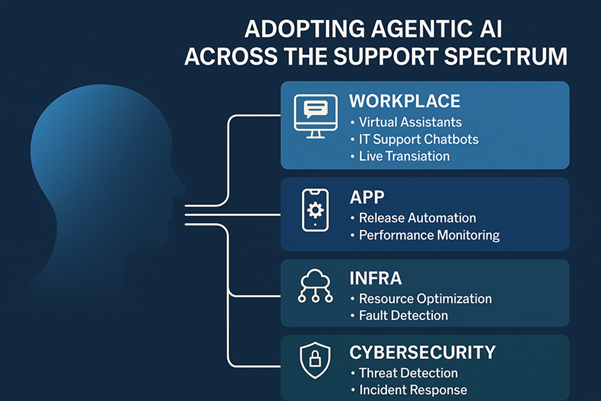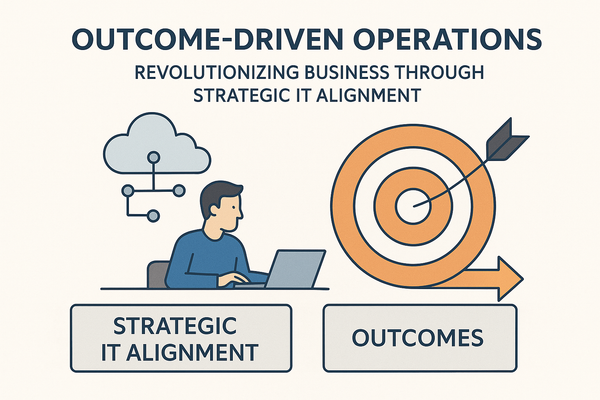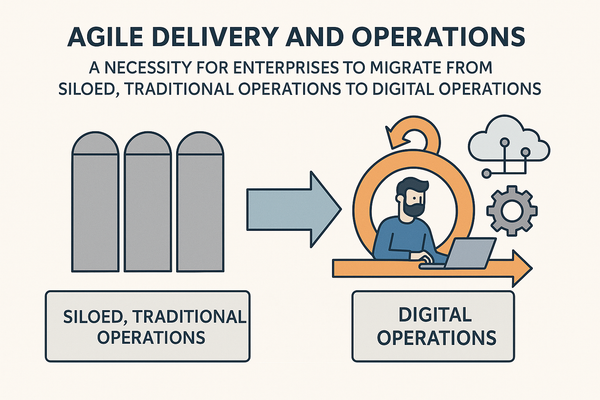Essential Components of an Enterprise Cognitive Automation Stack
This blog is an attempt to describe how agentic AI is being implemented across various enterprise support domains such as workplace, applications, infrastructure, cybersecurity, and DevSecOps.

In today's digital-first environment, enterprises constantly strive to enhance user experience, optimize operations, and fortify cybersecurity. Agentic AI, characterized by its ability to independently act, reason, and make decisions, has emerged as a crucial enabler across IT support functions. By intelligently automating and orchestrating workflows across workplace, application, infrastructure, cybersecurity, and DevSecOps domains, agentic AI enhances operational efficiencies and significantly improves user experience.
Enterprise Adoption of Agentic AI Across the Support Spectrum
Adopting agentic AI in enterprises involves addressing distinct but interconnected support domains:
Workplace Support
Workplace support ensures employees have seamless access to the technology and services required for daily tasks.
- Virtual Assistants: Tools like Microsoft Copilot, Google Bard, and ServiceNow Virtual Agent deliver end-user support via intelligent chatbots.
- Proactive Issue Detection: Nexthink leverages AI analytics to detect and remediate IT issues proactively, improving user productivity.
Application Support
Application support ensures high availability, performance, and seamless functioning of enterprise applications.
- AIOps Platforms: Dynatrace, AppDynamics, and Splunk ITSI monitor and diagnose issues in real-time, enabling autonomous resolution.
- Observability: Tools like Datadog and New Relic detect anomalies and perform automated remediation.
Infrastructure Support
Infrastructure support ensures reliability, scalability, and availability of IT infrastructure.
- Autonomous Infrastructure Management: Nutanix Prism, VMware Aria, and IBM Turbonomic adjust resources using AI.
- Intelligent Monitoring: Tools like ScienceLogic and OpsRamp enhance infrastructure performance.
Cybersecurity Support
Cybersecurity support protects enterprise systems from evolving threats.
- Threat Detection and Response: Platforms such as Palo Alto Cortex XDR, Darktrace, and CrowdStrike provide autonomous security.
- Vulnerability Management: Tenable and Qualys prioritize and automate patching based on AI risk analysis.
DevSecOps Integration
DevSecOps integrates security into the CI/CD pipeline for secure software delivery.
- Security Automation: Checkmarx, Veracode, and SonarQube use AI for early vulnerability detection.
- CI/CD Pipelines: Jenkins, GitLab CI/CD, and Azure DevOps automate secure deployments.
Tools and Agents Enhancing End-User Experience and Automation
|
Domain |
Tools |
Capabilities |
|
Workplace |
Nexthink, Microsoft Copilot,
Google Bard, ServiceNow Virtual Agent, Google Translate API, Microsoft Azure
Translator |
Real-time insights, proactive
IT issue remediation, virtual assistant support, multilingual support via
live translation |
|
Applications |
Dynatrace, Splunk ITSI,
AppDynamics, Datadog |
Real-time monitoring, anomaly
detection, root-cause analysis, automated remediation |
|
Infrastructure |
Nutanix Prism, VMware Aria, IBM
Turbonomic, OpsRamp, ScienceLogic |
Predictive resource allocation,
proactive monitoring, automated infrastructure management |
|
Cybersecurity |
CrowdStrike Falcon, Darktrace,
Palo Alto Cortex XDR, Qualys, Tenable |
Autonomous threat detection,
response, vulnerability prioritization, automated patch management |
|
DevSecOps |
Checkmarx, Veracode, SonarQube,
Jenkins, GitLab CI/CD, Azure DevOps |
Automated vulnerability
scanning, secure continuous integration/deployment, compliance checking |
Automating Housekeeping Activities in the IT Environment
AI-driven tools automate routine operations, freeing up IT personnel for strategic tasks:
- Patch and Compliance Management: Tenable and Qualys automate risk-based patching.
- Configuration and Drift Management: Ansible identifies and resolves configuration drifts.
- Incident Auto-Resolution: ServiceNow Predictive Intelligence and Splunk ITSI automate resolution workflows.
- Resource Optimization: VMware Aria and IBM Turbonomic optimize workload performance.
Building an Enterprise AI Fabric Across the Support Spectrum
A unified AI Fabric connects specialized tools into an interoperable automation layer across domains.
Integration and Interoperability – Functional Overview and Pictorial View
To build a seamless AI-driven IT support environment, each layer in the AI Fabric plays a critical role. Here's a breakdown:
- AI Orchestration: Acts as the command center that coordinates AI agents and workflows across domains. Tools like IBM Cloud Pak and VMware Aria Suite provide rule-based orchestration, real-time decision-making, and root-cause correlation.
- Observability & Monitoring: Offers real-time telemetry and actionable insights across applications, systems, and services. Dynatrace, Splunk ITSI, and Datadog integrate logs, metrics, and traces to detect issues proactively.
- ITSM & Automation: Automates service management workflows and provides a structured interface for incident, request, change, and problem management. Platforms like ServiceNow and Jira Service Management enable AI-based ticket triage and auto-resolution.
- Infrastructure Automation: Dynamically manages compute, storage, and network resources using AI for capacity planning and fault mitigation. Tools like Nutanix Prism and IBM Turbonomic ensure optimal infrastructure performance.
- Cybersecurity Automation: Continuously monitors for threats and performs real-time risk assessments. Tools such as CrowdStrike, Palo Alto XDR, and Darktrace automate threat detection, response, and policy enforcement.
- DevSecOps: Embeds security controls into the software development pipeline. CI/CD tools like Jenkins, GitLab, and Checkmarx automate secure code delivery, compliance checks, and vulnerability scans.
- User Experience Management: Captures employee sentiment, system performance, and digital experience metrics. Nexthink and Lakeside SysTrack help IT prioritize interventions that improve workplace satisfaction.
- AI Middleware: Ensures seamless integration between platforms using APIs, connectors, and messaging queues. IBM Integration and MuleSoft are key enablers.
- Data Lake & Analytics: Aggregates data from all domains to generate cross-functional insights using ML models. Snowflake and Databricks serve as the intelligence core of the AI Fabric.
Enterprise AI Fabric Integration

This interconnected structure ensures seamless data flow, real-time decision-making, and automation across enterprise functions.
Why Enterprises Must Adopt an AI Fabric
AI is increasingly entrenched in IT operations. As per Gartner, by 2025, AI-based systems will reduce IT downtime by 40% [1]. IDC reports enterprises that deploy AI automation see up to 60% improvements in operational efficiency [2]. Forrester highlights that non-adopters risk competitive decline [3]. According to BCG, AI adopters consistently outperform in innovation and productivity [4]. HfS Research warns that lacking a cohesive AI Fabric can lead to fragmented operations and cybersecurity gaps [5].
Organizations that ignore these trends risk operational inefficiencies, higher costs, and slower digital innovation.
Considering the Broader Landscape: Challenges, Costs, and Human Impact
While the sources provide a strong case for the what and why of agentic AI adoption and the vision of an AI Fabric, a complete understanding requires addressing the practical challenges, costs, and human factors involved in this transformation.
Challenges of Adoption and Implementation
Adopting agentic AI and building a cohesive AI Fabric is a complex undertaking. Enterprises must navigate:
- Technical Integration: Connecting legacy systems, modern AI platforms, and data sources across the Data Lake & Analytics layer demands significant architectural re-engineering.
- Security Risks: AI systems introduce new attack surfaces and must be secured against exploitation.
- Vendor Lock-in: Relying on specific AI platforms can limit flexibility and increase switching costs.
- Data Quality and Governance: Ensuring accurate, unbiased, and compliant data flows is critical for AI effectiveness.
Costs and ROI Considerations
AI adoption requires a balanced assessment of costs and returns:
- Upfront Investments: Licensing AI tools, upgrading infrastructure, and building integration layers can be capital-intensive.
- Operational Costs: Ongoing expenses include AI model maintenance, monitoring, and the cost of specialized talent.
- Measuring ROI: Success is measured not just in cost savings but also in improved security, enhanced user experience, faster innovation, and risk reduction.
Organizational and Human Impact
AI reshapes the workforce:
- Role Evolution: Routine IT tasks shift to AI, requiring humans to focus on AI governance, strategic decision-making, and ethical oversight.
- Reskilling Imperative: Upskilling in AI technologies, data analysis, and AI ethics is essential.
- Change Management: Clear communication and training help address concerns about job displacement and foster trust in AI systems.
Ethical Considerations and Governance
Agentic AI raises important ethical and regulatory issues:
- Bias and Fairness: AI models can reinforce biases if not properly managed, impacting ticket prioritization, resource allocation, and incident resolution.
- Transparency: Enterprises must ensure explainability of AI decisions, especially in troubleshooting and audits.
- Accountability: Defining ownership when AI systems make decisions is critical.
- Data Privacy and Compliance: Enterprises must balance AI-driven insights with privacy regulations and user consent.
Adoption Strategies and Phased Rollouts
Enterprises typically implement AI Fabric in stages:
- Start with pilot projects in high-impact areas like incident response or virtual assistance.
- Prioritize use cases based on ROI potential, risk profile, and complexity.
- Build incrementally, adding systems and domains as capabilities mature.
Metrics for Success
Tracking AI Fabric success requires detailed metrics:
- Operational KPIs: Mean Time to Resolution (MTTR), incident auto-resolution rates, accuracy of threat detection, etc.
- End-User Metrics: User satisfaction scores, percentage of tickets resolved by AI agents.
- Business Impact: Cost reductions, productivity improvements, risk mitigation outcomes.
Vendor Landscape and Comparative Analysis
The AI market is vast and evolving. Enterprises must:
- Conduct detailed evaluations of AI tools for compatibility, scalability, integration capabilities, and total cost of ownership.
- Continuously reassess the vendor landscape as technologies evolve.
By addressing these challenges and adopting a thoughtful, phased approach, enterprises can realize the full potential of an AI Fabric, ensuring it delivers meaningful value while minimizing risks.
References
[1] Gartner: Top Strategic Predictions for 2025 and Beyond – https://www.apmdigest.com/gartner-top-predictions-it-organizations-and-users-2025-and-beyond
[2] IDC: Worldwide Artificial Intelligence and Automation 2025 Predictions – https://www.idc.com/research/viewtoc.jsp?containerId=US51666724
[3] Forrester: Generative AI Trends for Business – https://www.forrester.com/technology/generative-ai/
[4] BCG: Closing the AI Impact Gap – https://www.bcg.com/publications/2025/closing-the-ai-impact-gap
[5] HfS Research: Only 12% of Enterprises Have Cracked the AI Maturity Code – https://www.hfsresearch.com/research/enterprises-cracked-ai-maturity/


